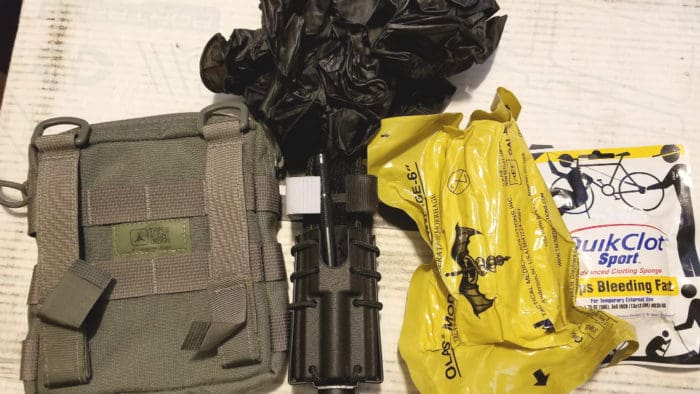Unfortunately, whether it’s a car crash or a spree shooter, the option of self-defense doesn’t always exist. Even if you technically could engage with a ballistic solution, the best option may very well be to unass the A-O, seek cover or a barricade, and have basic trauma care gear and training under your belt. Some basic training and a small medical kit can go a very long way.
At a recent gun industry press trip, I met with writers and professionals from around the country. On my backpack? The basic medical kit seen above. Out of approximately 20 of us, I believe only three of us carried medical supplies and one of those was an active law enforcement investigator.
My kit is embarrassingly sparse with an admittedly myopic focus on bleeding, but it’s more and better than nothing.
I carry a tourniquet, Olaes compression bandage, QuickClot (a larger kit version is available here), and nitrile gloves. Those hotlinks are to the actual products I’m carrying. I have the same items in the glove compartments of our vehicles as well. And I’ll list some other options below.
Perhaps the thing about my kit is that I don’t actually carry any of it on my person proper. My med pack is attached to the MOLLE webbing of my backpack (a TAD Fast Pack Lightspeed) and is popped off and dropped in my range bag (or elsewhere) if I’m traveling sans backpack.
While each car has a kit, I can’t say that I would have necessarily had any of these things on me at an event like a concert.
I may have to change that. One of the other guys equipped with basic trauma care supplies at that press event was Riley Bowman, Director of Training & Media Production at ConcealedCarry.com. Riley has carried medical supplies and other goodies in an ankle rig for many years now.
While I’m not sure I’ll go the ankle carry route (US Palm closed its doors, but other ankle medical systems include the Ricci, Rescue Essential’s AMS, and the Frog.Pro SFD-Responder), Riley’s choice has inspired me to transfer an even more basic kit to my on-person carry and beef up my off-person kits.
Often sold with a tight-fitting elastic sleeve, a RATS is easy to simply toss in a pocket. Some folks choose to wear them on top of their belt or even as a belt. The easier it is to have on you, the more likely you are to have it on you, so I’ve ordered up a RATS to experiment with carrying it daily.
For my pack, I’ll be adding a second tourniquet to each, plus an airway, tape and gauze, and chest seal like the stuff included in the Tactical Distrubutors kit seen above. Via that link you’ll also see the ITS ETA Tallboy and Fatboy Trauma Kit Pouches, which are quick-access packs designed for storing, in an organized manner, all of the sorts of medical trauma supplies we’re kicking around here.
As for CAT-style tourniquets, after similar recommendations from multiple people in the know, I’ve switched from a cheaper versions to better models with an aluminum windlass and Kevlar reinforcements. They’re available in a two-pack here.
The same goes for Israeli bandages. Don’t go for the least expensive option. That said, I have similar Olaes bandage in my packs, but all of this wrapping and compression could also be achieved with ACE Wrap and Kerlix.
Especially if you go the ACE and gauze route — but even if you don’t — trauma shears come in extremely handy. Or so I’ve been told. I have approximately zero of them and am now adding one to each of my kits.
Finally, none of this equipment is particularly helpful without some training. I took some basic training with Tactical Fitness Austin. It was immensely educational, teaching not only the medical side, but also the evac side.
If you can’t shoot back — or often even if you can — get off the X, seek cover, and be prepared. There were stories of concert-goers saving lives by applying tourniquets in Las Vegas, and it was left to them to evacuate victims to where medical first responders were staged some distance from the scene until it was declared safe. With some basic training and even sparse equipment, anyone can help save lives.
